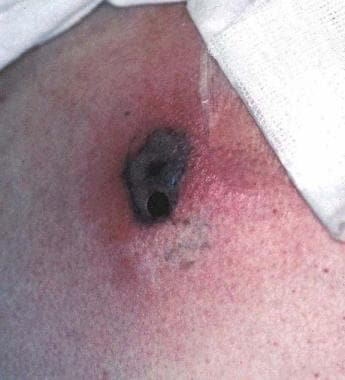Background
Cutaneous aspergillosis is usually a cutaneous manifestation of disseminated infection with the fungus Aspergillus. Primary cutaneous disease is rare and is most commonly caused by Aspergillus fumigatus and Aspergillus flavus. Rare cutaneous infections have been reported with Aspergillus terreus and Aspergillus ustus.
Colonization of burn eschars by Aspergillus is common, and reports have described primary cutaneous infection in immunocompetent patients in association with agricultural trauma. [1] Usually, however, aspergillosis begins as a pulmonary infection subsequent to inhalation of fungal spores. In the immunocompromised host, hematogenous dissemination and invasion of other organ systems, including the skin, often follows the initial pulmonary infection.
Dermatologic manifestations of disseminated aspergillosis include single or multiple erythematous-to-violaceous plaques or papules, often characterized by a central necrotic ulcer or eschar. Skin lesions occur in 5-10% of patients with disseminated aspergillosis. In primary cutaneous aspergillosis, the most typical presentation is implantation of the fungus following trauma, including infections at the site of intravenous cannulas, or venipuncture wounds, especially those that have been covered with occlusive dressings. Note the image below. Aspergillus is a frequent contaminant found in cultures of dystrophic nails, but it can occasionally cause a true onychomycosis.
Pathophysiology
Cutaneous aspergillosis is caused by infection with ubiquitous soil- and water-dwelling saprophytes of the Aspergillus genus. Infection from Aspergillus could happen through a wound in the skin (eg, surgery or scratch), where it enters the immunocompromised body (eg, from organ transplantation). Cutaneous aspergillosis could also develop from invasive aspergillosis spreading to different parts of the body. Typically, infection of the pulmonary system occurs via inhalation of fungal spores, which then leads to disseminated hematogenous infection with the organism. A fumigatus is the most common pathogen associated with disseminated disease with cutaneous involvement, whereas A flavus [2] or A terreus most often causes the less frequent primary infections of the skin. Aspergillus niger and A ustus have also been cultured from cutaneous lesions. [3] Infections of the sinuses, lungs, or skin can lead to disseminated disease, especially in patients who are immunocompromised, are on the rise. Initial cutaneous lesions may appear in the form of either macules, papules, nodules, or plaques. [4] Although rare, cases of primary cutaneous infection with Aspergillus have been described in immunocompetent patients. [5, 6]
Etiology
Aspergillosis is an uncommon disease in patients who are not immunocompromised because normal neutrophilic and macrophagic functions prevent infection; however, any deficiency in these immunologic parameters increases the risk of aspergillosis. For example, systemic corticosteroid therapy is a known risk factor for cutaneous aspergillosis. Secondary cutaneous aspergillosis has been reported in an asthma patient on 1 month of steroid treatment. [7]
Some environmental risk factors have also been implicated in cutaneous aspergillosis; these factors include construction sites and contaminated ventilation systems, presumably caused by effects on spore distribution.
Epidemiology
Frequency
Aspergillosis is the second most common opportunistic fungal infection in patients who are immunocompromised, accounting for as many as 20% of fungal infections in patients who have received bone marrow or solid organ transplants. Key risk factors for cutaneous aspergillosis include neutropenia from hematologic malignancy or chemotherapy, immunosuppressive therapy, AIDS, diabetes, tissue damage, allogenic hematopoietic stem cell transplant, and cytomegalovirus infection.
Sex
No clear sexual predilection is reported for cutaneous aspergillosis.
Age
Neonates occasionally develop disseminated aspergillosis, presumably because of their immature immune mechanisms.
Prognosis
When cutaneous aspergillosis occurs in the setting of systemic aspergillosis, the prognosis is poor. Disseminated aspergillosis is associated with a mortality rate of greater than 90%. In contrast, multiple case reports have documented resolution of primary cutaneous aspergillosis after surgical excision followed by, in some cases, systemic antifungal therapy.
-
Primary cutaneous aspergillosis at a site of an intravenous catheter in a boy with leukemia.










